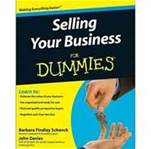
Determining how much your business is worth so you can decide how much to sell it for is an important issue. Obviously, you do not want to price it too low and leave money behind, but you also do not want to run buyers off by asking a price they find out of line.
The most commonly used approach for pricing a business is the multiple-of-earnings approach. In this approach, you assess the attractiveness of your business mainly in the areas of financial strength, health of the business and market area strength. Then adjust for risks that accompany your business or sale terms you will offer. Based on the outcome of your assessment, rate your business offering on a scale of one to five. This rating becomes what is known as the earnings multiple. A business with growing earnings and strong operations that can easily transfer to a new owner win a higher earnings multiple than a similar business with lower earnings, weaker operation or a challenging seller-to-owner transfer. After setting the earnings multiple, you apply it to the amount of money your business earns annually to come up with a reasonable price. Multiple your annual sellers discretionary earnings by your earnings multiple to arrive at a price you think you can charge and what a buyer would be willing to pay. After you have arrived at your estimate, enlist the help of your accountant, business broker or business valuation firm to reach a collective and accurate pricing decision.
Make a List
Pulling best-guess numbers out of your head is not the best way to assess the value of your business; you will need the following information:
- Financial Statements Financial records that go back three to five years or since inception is your business is newer. The statement of seller’s discretionary earnings showing the add backs for all expenses benefitting the owner and the bottom line. You need to show exactly how much profit your business generates for the owner annually.
- Value of Business Assets There are two types of assets, the ones you can see and touch and the ones you cannot, tangible or intangible.
- Sale Price of Comparable Businesses Research the price of similar businesses for sale in your industry and market area.
- Assessment of Business Strengths and Risks The growth potential, ease of transfer or limitations to the business.
- Sale Terms Financing is necessary to business sales and a seller who offers financing terms such as accepting part of the purchase price in deferred payments or financing of a portion until a defined point in the future, is more attractive to buyers. Some studies indicate by enhancing the sale terms and offering seller financing that it will earn multiples nearly one-third higher than businesses that require all-cash at closing.
Gather Information from Those In the Know To learn how businesses in the market compare to yours seek advice from those whose livelihoods depend on advising businesses. Contact a business broker in the area who has information on recent sales and average sale prices. As if the broker has handled or has information for sales of your business size and type. Then ask if they can share generalities about how the businesses were price. Industry associations can also provide data on selling trends. If you are selling a franchise, go to the franchisor who likely can share current information on sale prices and pricing approaches.
Market Trends Certain businesses are more attractive to buyers and those businesses tend to sell for higher-than-average earnings multiples.
- Manufacturing Businesses can go for earnings multiples of four or higher so long as the product being manufactured is competitive and has strong growth
- Distributorships are typically priced at a higher end of the scale if they have strong earnings
- Equipment Intensive Businesses with current attractive assets, positive sales and good earnings win higher prices
- Service and Retail businesses are generally priced lower on the scale with businesses facing stiff competition, earnings multiples are usually between one and two
- Food Service businesses are priced in the middle if they are profitable, lower if the business is struggling
A recent search of industry market data showed that median valuation multiples by industry group for all sales ranges averaged a 3.7 multiple-of-earnings rate. The chart below shows the specific valuation multiples by industry.

Get Clear About What You Are Selling
Think of selling your home for a moment. If you sell it fully furnished, you price it differently than if you sell it cleared out down to the carpet and fixtures. If it has outstanding features that go with the deal – amazing landscape, top-of-the-line appliances, and electronics – the price will cover those assets. If your home is in a desirable location, you charge more. The same goes for selling a business and the more attractive your offering, the higher your earnings multiple and therefore the higher your asking price. The biggest difference between selling a home and selling a business is that a home sale includes the structure, fixtures, land, maybe even furnishings and equipment. When you sell a business, it is considered an entity sale or stock sale. An asset sale is like selling the contents of a home, even the address, but not the structure itself. An entity sale affects how sale proceeds are taxed and how liabilities are held or transferred. Buyers will want to be clear on whether you are offering an asset sale or an entity and exactly what the sale price covers.
If you are selling assets In this sale the seller keeps the actual legal business structure, the business entity, and sells the assets that include the tangibles such as furnishings, fixtures, equipment, accounts receivable, inventory and intangibles like the business name and reputation. If your business is a sole proprietorship, your only choice to structure your deal is an asset sale. After the sale is complete, assets are transferred to the buyer and your sole proprietorship ceases to exist automatically closing down. If your business is a corporation or LLC, after business assets are transferred to the buyer, your business entity will likely have no remaining value and you will work with your trusted advisors to close it down.
Selling an entity In this type of sale the owner of a corporation sells its stock to a new owner and the owner of an LLC sells its membership shares. Because the stockholders own the assets and liabilities of the business when the shares are transferred from the seller to the buyer everything that the business owns and owes goes with them unless specifically excluded. For that reason sellers typically prefer an entity sale but buyers do not always favor this deal structure. The decision for a corporation or LLC to sell assets or an entity involves negotiation because of the transfer of liabilities and because of tax implications.
Valuing Your Tangible and Intangible Assets
Figure out the value of everything that you own so you can compare that total to the sale price you determined through the multiple-of-earnings approach. By comparing the two numbers, it confirms your price covers the value of what you are selling. Create inventory lists and assign values to tangible assets such as furnishings, fixtures, equipment, real estate, automobiles, and intangible assets like intellectual property, trademarks, goodwill, reputation, competitive advantage, and ease of transfer.
Tangible assets are easiest to price often you can find comparable items on the market or internet sites, through distributors and outlet stores. Buyers want to see the assets and value at a glance so simplify how you present the information. Group assets into categories and create a chart to identify the description and value.
Intangible assets are more difficult to value. The business name, reputation, process, strategies, and general knowledge all contribute to the value of the business. Goodwill includes your business name and identity, trained workforce, clientele, durable supplier and distribution networks, phone numbers and websites, and any proprietary technology systems or processes unique to the business. Goodwill can comprise much of the value of a business owned by a hairdresser, veterinarian, dentist or marketing business for example. If the brand is strong the business has a high goodwill value and the owner can use this to justify a business price with a higher-than-average earnings multiple.
Something to consider After tallying up the value of the physical assets and inventory, some business owners will decide they are better off selling the tangible assets individually rather than undergoing the time, effort, and resources to sell all assets tangible and intangible through a business sale. If the sale price is lower than the value of your assets then unfortunately the parts of your business are worth more than the whole of your business. That is a strong sign you might be better off liquidating and selling assets instead of proceeding with a business sale.
Your Number By determining what you are selling, the tangible and intangible assets, and applying common pricing approaches such as multiple-of-earnings and market trends you should now have a number in mind. This number is your starting point and likely will be adjusted by your accountant, broker, or buyer during negotiations. However, for now you should have a good idea of what to charge for your business and how to defend the price.




